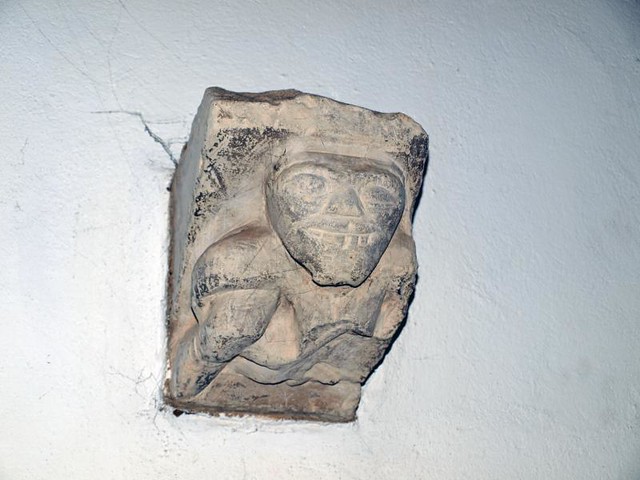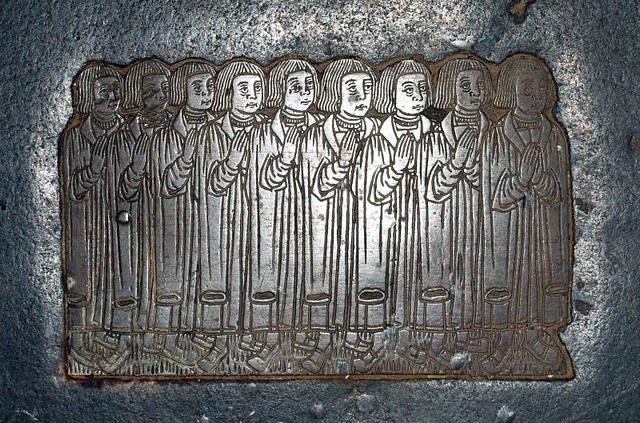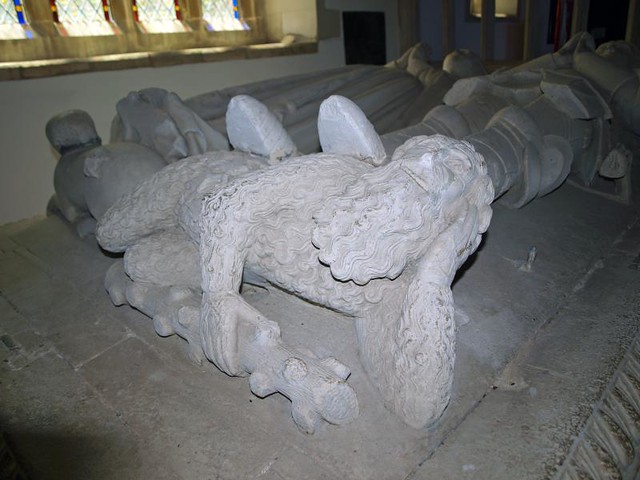ST JOHN THE BAPTIST. Tall, slender W tower with slim diagonal buttresses. In contrast to its vertical elevation the long, relatively low nave and yet lower chancel, an impressive opposition of vertical and horizontal. The chancel is embattled. Its masonry is the oldest part of the church, as proved by a small C13 lancet window in the N wall and a low side lancet in the S wall. The nave arcades are early C14 with octagonal piers carrying moulded capitals typical of that date and double-hollow-chamfered arches. One pier on the S side is broader than the others, perhaps for a screen. The staircase in the S aisle does not, however, correspond to it. It led to the parvis above the porch. The E bays have renewed piers. The N chancel chapel must also be early C14. The tower arch is a little later. - In the N aisle wall is a figure CORBEL, very coarse, yet probably later than the C13, which is the date suggested by the Royal Commission. - LECTERN. C16, of timber. - PLATE. Cup of 1514; secular.
The most remarkable part of the church is the PENDLEY CHAPEL. It is divided from the aisle and the chancel by an excellent stone SCREEN with original Perp tracery and a castellated top. In it is the MONUMENT to Sir Robert Whittingham d. 1471 and his wife, two recumbent stone figures on a tomb-chest with weepers alternating with shields. The monument and the screen came from Ashbridge in 1575-6. Against the E wall the later epitaph to Sir Richard Anderson d. 1699 and his wife, with two elegant busts. - MONUMENTS in other parts of the church; Sir Ralph Verney d. 1546 with wife and children, large brasses on stone tomb-chest decorated with shields. Also from Ashbridge. - Tiny brass to John Davies (E respond, N arcade), late C15. - Epitaph to Thomas Hyde d. 1570 and his son d. 1580 (N chancel chapel) with exquisite strapwork decoration but no figures.
Aldbury. Through lattice windows the 300-year-old timbered manor house looks on to the village pond, the stocks, and the whipping-post, and the old cottages gather round happily, surveying the tranquil scene. A little farther on are the almshouses, three or four tiny black-beamed yellow cottages, weighed down under the thatch of 300 years; and in front of all is the ridge of a beech-clad hill, topped by a column nearly 200 feet high in memory of the Duke of Bridgewater and his Canal.
The old parts of the church are mostly 14th century, with a square tower of the 15th; but there is much that is new. In a glass case is the pipe with three notes blown by the clerk to give the pitch in the days before organs. Older treasures are a 16th-century wooden lectern, some fragments of 15th- and 16th-century glass, a chalice of 1514, some medieval tiles, and a stone coffin lid; but the chief interest of the church lies in the monuments of the knights and ladies from the three big houses of Pendley, the Manor, and Stocks.
The beautiful medieval stone screen round most of the Pendley memorials was brought from Ashridge monastery on the other side of the ridge, and with it the tomb and the perfect sculptured figure of the builder of Pendley, Sir Robert Whittingham, a Lancastrian killed at the battle of Tewkesbury. He lies by his wife, in his armour and SS collar, with his feet on the wild man, or wodehouse, familiar in heraldry and derived from a standard character in medieval pageants and mystery plays. Round the tomb are carved the family shields and on the wall hang two old helmets. If Sir Robert could turn his head he might look through a peephole to the altar, but he gazes at the pompous wigged busts of an ancient couple who owned his house 200 years after him, and at the records of the Harcourt family who followed them. Four little Harcourts have an imposing collection of godmothers and godfathers, a queen, a princess, a bishop, and two Georgian kings.
The staunch Lancastrian’s daughter married a Yorkist, Sir John Verney, and Pendley went with her, York and Lancaster coming here to rest in the same tomb. Their descendants, Sir Ralph Verney, his wife, and their nine sons and three daughters, have magnificent brass portraits rich in heraldic design on an altar tomb in the north chapel. On a pillar is a small brass figure of a 15th-century London merchant, John Davers.
The manor house is represented in the church by a curious monument to Sir Thomas Hyde, who died in 1570, and Stocks, where the Duncombes lived for 500 years, by an inscription to the last of the family, who ordered the black marble top of the table in his bowling-green house to be used as his monument. Here it is, and outside is the grave of Mrs Humphry Ward, who also lived at Stocks, and there wrote in her novel, Bessie Costrell, a vivid description of this village where so little has changed since the sundial was put on its carved wooden post in the churchyard 300 years ago. Mrs Ward was the granddaughter of the famous Dr Arnold of Rugby, and was born in Tasmania, though brought to England when she was only five. She grew up to take a deep interest in social work, believing that to be the best form of Christianity, and she expounded her views in her best-known novel, Robert Elsmere, which had a tremendous success, being reviewed by Mr Gladstone. With a group of friends she founded a University Settlement, and set on foot many schemes for increasing the happiness of cripple children. She was one of the first women magistrates.
The old parts of the church are mostly 14th century, with a square tower of the 15th; but there is much that is new. In a glass case is the pipe with three notes blown by the clerk to give the pitch in the days before organs. Older treasures are a 16th-century wooden lectern, some fragments of 15th- and 16th-century glass, a chalice of 1514, some medieval tiles, and a stone coffin lid; but the chief interest of the church lies in the monuments of the knights and ladies from the three big houses of Pendley, the Manor, and Stocks.
The beautiful medieval stone screen round most of the Pendley memorials was brought from Ashridge monastery on the other side of the ridge, and with it the tomb and the perfect sculptured figure of the builder of Pendley, Sir Robert Whittingham, a Lancastrian killed at the battle of Tewkesbury. He lies by his wife, in his armour and SS collar, with his feet on the wild man, or wodehouse, familiar in heraldry and derived from a standard character in medieval pageants and mystery plays. Round the tomb are carved the family shields and on the wall hang two old helmets. If Sir Robert could turn his head he might look through a peephole to the altar, but he gazes at the pompous wigged busts of an ancient couple who owned his house 200 years after him, and at the records of the Harcourt family who followed them. Four little Harcourts have an imposing collection of godmothers and godfathers, a queen, a princess, a bishop, and two Georgian kings.
The staunch Lancastrian’s daughter married a Yorkist, Sir John Verney, and Pendley went with her, York and Lancaster coming here to rest in the same tomb. Their descendants, Sir Ralph Verney, his wife, and their nine sons and three daughters, have magnificent brass portraits rich in heraldic design on an altar tomb in the north chapel. On a pillar is a small brass figure of a 15th-century London merchant, John Davers.
The manor house is represented in the church by a curious monument to Sir Thomas Hyde, who died in 1570, and Stocks, where the Duncombes lived for 500 years, by an inscription to the last of the family, who ordered the black marble top of the table in his bowling-green house to be used as his monument. Here it is, and outside is the grave of Mrs Humphry Ward, who also lived at Stocks, and there wrote in her novel, Bessie Costrell, a vivid description of this village where so little has changed since the sundial was put on its carved wooden post in the churchyard 300 years ago. Mrs Ward was the granddaughter of the famous Dr Arnold of Rugby, and was born in Tasmania, though brought to England when she was only five. She grew up to take a deep interest in social work, believing that to be the best form of Christianity, and she expounded her views in her best-known novel, Robert Elsmere, which had a tremendous success, being reviewed by Mr Gladstone. With a group of friends she founded a University Settlement, and set on foot many schemes for increasing the happiness of cripple children. She was one of the first women magistrates.



No comments:
Post a Comment